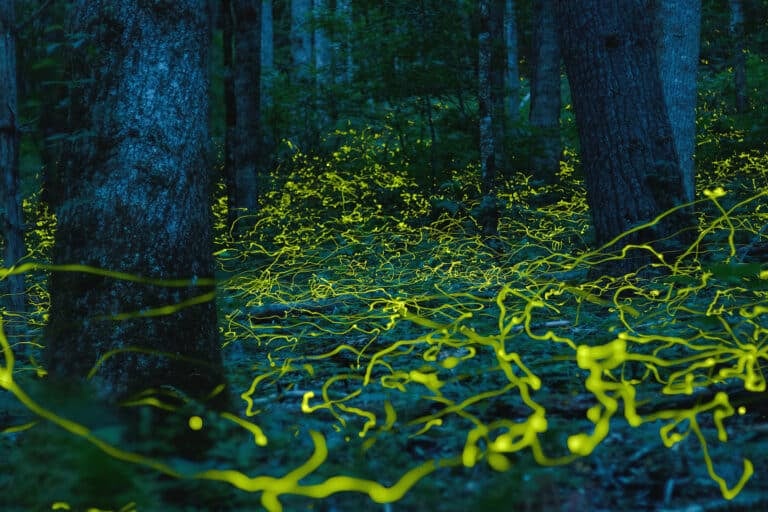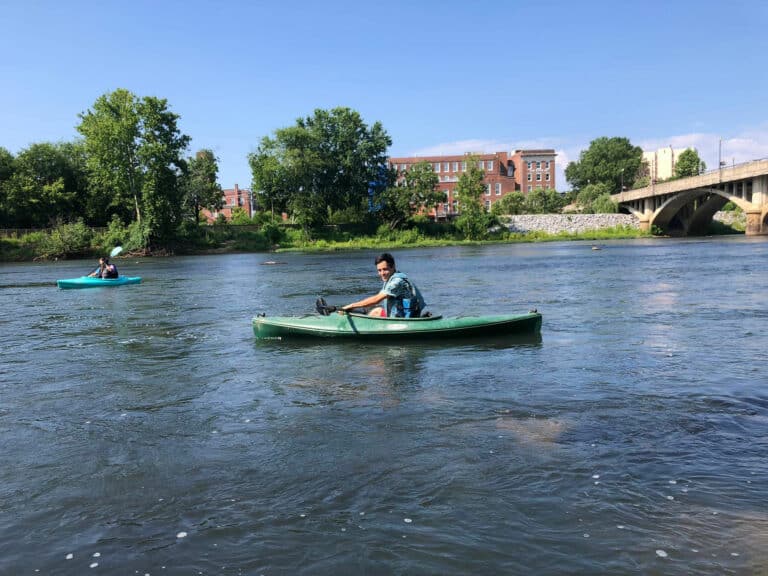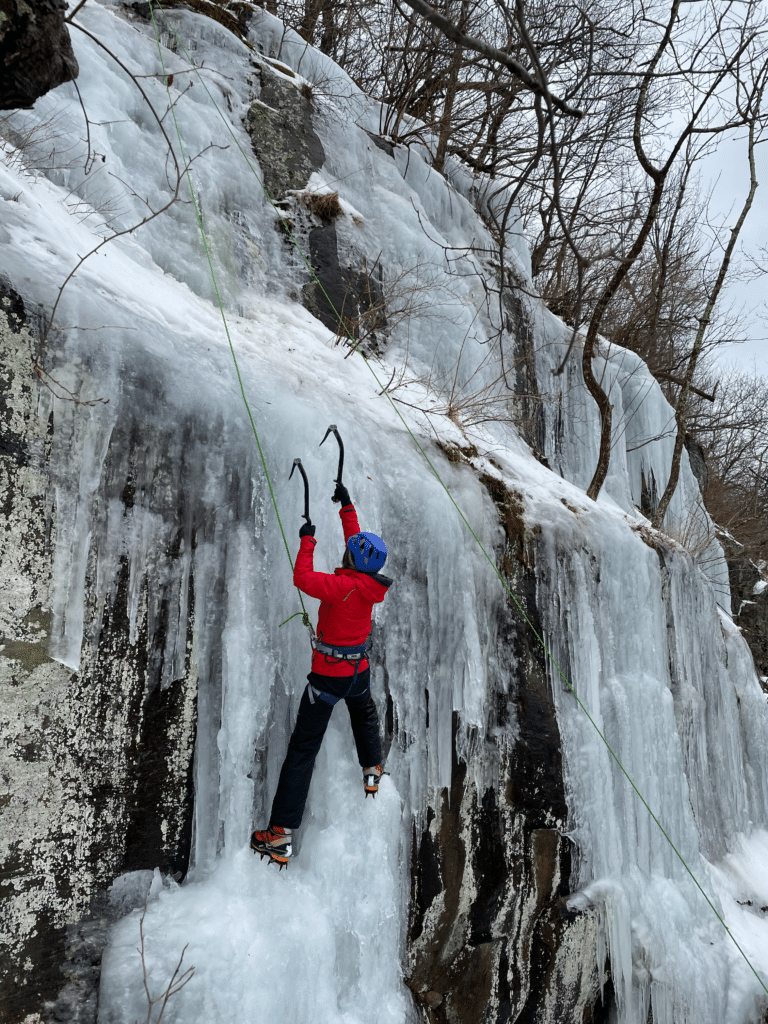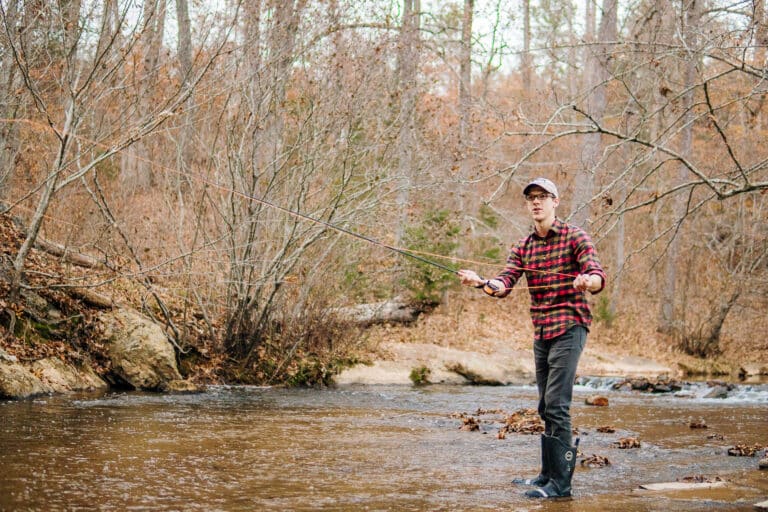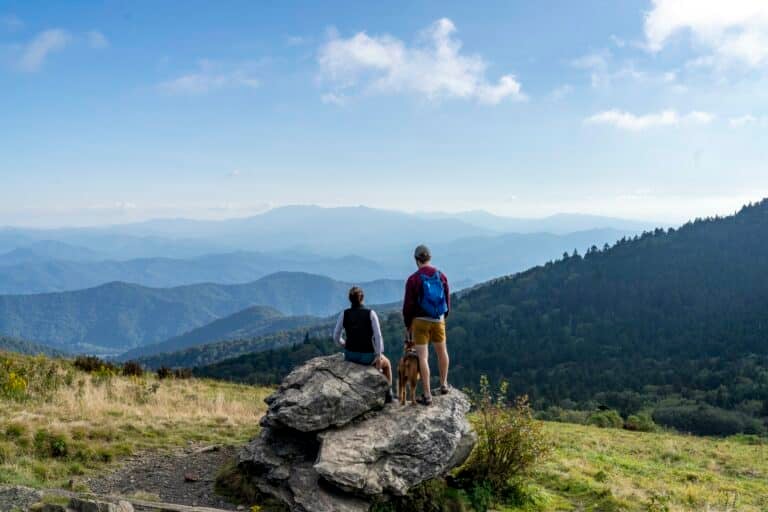It’s 10:30 pm when we arrive at Seven Springs Mountain Resort’s mountain operations headquarters. I’m one of a half-dozen group of visiting writers and bloggers, here to get a behind the scenes glimpse at what it takes to make snow. Together, we waddle into the shop like penguins, bracing against the violent wind.
Kirk Russell, the Seven Springs Mountain Manager, is there to greet us. His broad build fills the doorframe. Dressed head to toe in Carhartt brown, his cheeks flushed from the constant freeze-thaw cycle of working outdoors, he gives our puffy-clad group a bemused smile.
“What, is it cold outside?” he says in that endearing Pittsburghian way, where ‘out’ sounds more like ‘aht’ and the intonation suggests he already knows the answer. He laughs and ushers us inside.
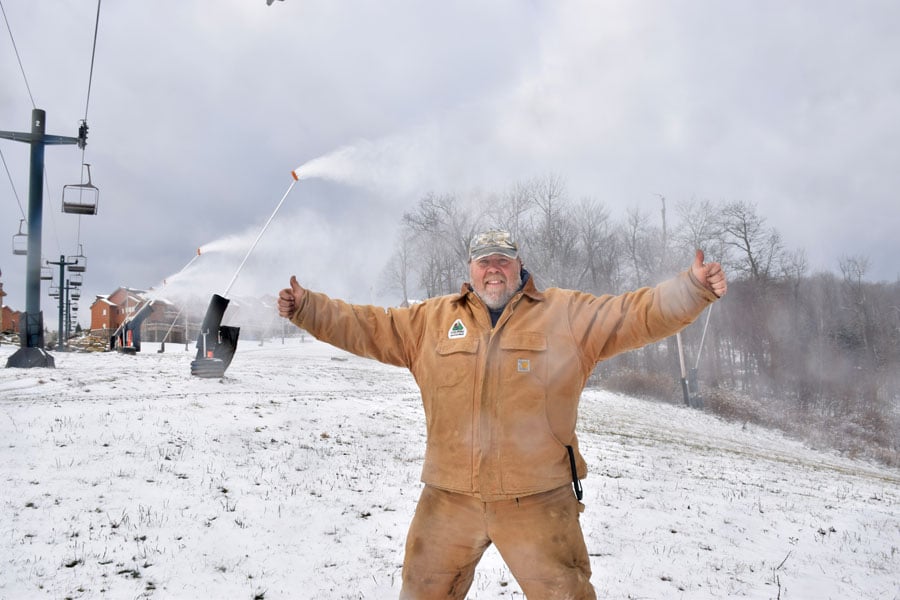
The shop floor is open and sparse in a utilitarian kind of way with large garage doors and ceilings tall enough to accommodate a couple of snowcats. There’s one parked there now, its engine purring, and we shuffle into the office as it backs out into the darkness of night.
“We used to have a wood stove in the shop, but we got rid of it because everyone would sit by it and thaw out and not want to go back outside,” says Russell. “Your coats get frozen to where you can hardly move your arms, like that kid in The Christmas Story. The smart guys take their frozen coats and stand them up outside while they take a break. A frozen coat is warmer than a wet coat.”
After 37 years of making snow at Seven Springs, Russell is full of other such anecdotal wisdom, which he dispenses to his crew like a grandfather would his grandchildren. In snowmaking expertise, Russell comes second only to the industry’s godfather, and his own mentor, Herman Dupré.
The son of Adolph Dupré, a German immigrant who settled on Seven Springs Farm and opened his property to skiers in the late 1930s, Herman was a master tinkerer. In 1960, Seven Springs installed their own double chairlift and snowmaking system, both of which were Herman Dupré’s designs.
Dupré later held 34 patents for his snowmaking systems, and that, in turn, evolved into HKD (for Herman Kress Dupré) Snowmakers, North America’s leading manufacturer of snowmaking technology. The company’s first product, the HKD Standard, was the first snowgun to be used ubiquitously in ski resorts. Now, the HKD SV10 is making its mark as one of the most energy-efficient guns available.
Russell knows this because he’s built many of HKD’s guns from the ground up.
“They needed someone who could weld, and that’s what got me in the shop,” Russell tells me later on the phone. “That was nice back then, because you weren’t outside freezing. Frostbite is no fun,” but, as Russell says, it comes with the territory. “If you get sprayed in the face with water at five degrees, it pretty much freezes instantly. It doesn’t take long walkin’ around with a frozen face for frostbite to get ya.”
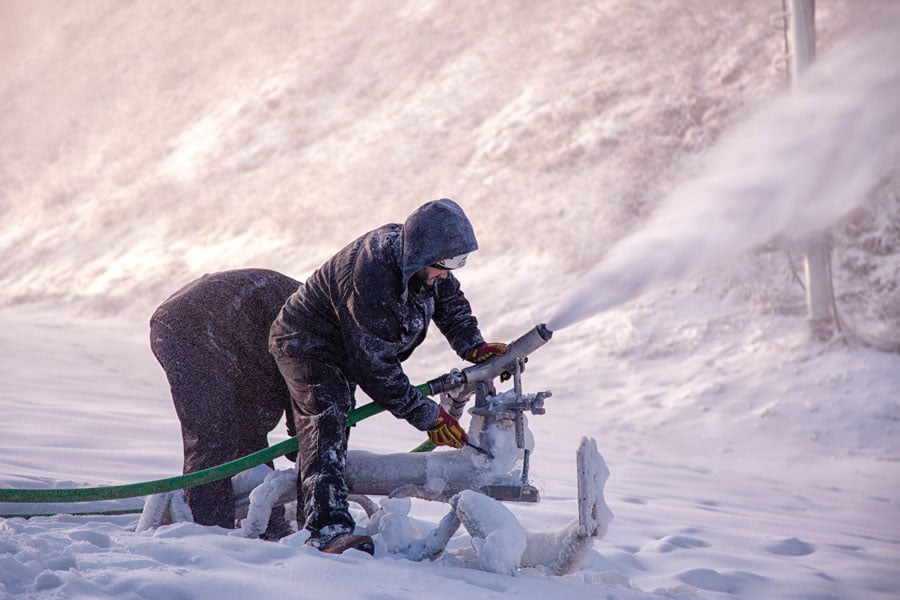
Our group trails behind Russell as he heads back outside. The thermometer reads a balmy 20 degrees, but with the wind, it feels well below that. He leads us to a snow gun and, with a few switch flips, brings it roaring to life. A wide jet of snow comes blasting out from the gun. He looks up at it, beaming.
“Well don’t just stand there,” he says, turning abruptly back toward the group. “Get up in there and see for yourself.”
Hesitantly, I step into the line of fire, er, snow. The force of the gun nearly knocks me down. Russell comes up and tugs at the hood of my jacket.
“Don’t want this stuff falling down your neck,” he says, “although it does pack a better punch than coffee. Just look at how it brushes right off your jacket. This is the good stuff.”
It’s light and fluffy and beautiful and I tell him as much, but my cheeks are starting to lose feeling. I step back out of the blast, but Russell stays put. Over the snow gun’s grumble, unfazed by its arctic squall, he launches into an impressively thorough summary of Seven Springs’ snowmaking operations: how the resort stores water in 40 collection ponds on the property including the main “stomach” Lake Tahoe; how the water is pumped from Lake Tahoe to the snow guns at a rate of almost 20,000 gallons of water per minute; that the resort’s 1,200 snow guns use less than 20 cubic feet of air per minute (cfm); that it takes 200,000 gallons of water to cover an acre of ground in one foot of snow; how over the course of the winter, the resort will use 350 million gallons of water and drain Lake Tahoe at least three times.
Shivering, trying desperately to absorb the facts, I can’t help but fixate on Russell’s total nonchalance of the elements. Small mounds of snow have accumulated on his shoulders, his beard a literal ice cube. I’m cold just looking at him.
“Aren’t you freezing?” I finally ask.
“Oh, once you build a layer of ice on ya, it insulates you to the point where you do stay warm.” Still, he admits, it’s not easy being out on the mountain all hours of the night in the middle of winter. “It’s hard to get people who are willing to do this type of work.”
[nextpage title=”Read on!”]
Philip Fuchs, Assistant Mountain Manager at Cataloochee Ski Area in Maggie Valley, N.C., knows the feeling. Fuchs has been at the resort for 18 years, and he says of all of the hurdles southern resorts face, finding reliable snowmaking employees is one of the biggest.
“If I’m just pulling an application out of the file and doing interviews, I’ve brought plenty of people on like that, straight off the street, but they usually make it about two weeks,” says Fuchs.
Between constant exposure to the cold and long 12-hour shifts, usually from 6pm to 6am when temperatures are coldest, making snow is hard, often thankless work. But as the Southeast and Mid-Atlantic continue to have record warm winters, snowmaking is more important now than ever before. Cataloochee depends on snowmaking to provide 90% of the mountain’s snow. Farther west, Tennessee’s Ober Gatlinburg, which sits between 2,700 and 3,300 feet in elevation, relies on snowmaking to provide over 95% of its snow base.
“There’s no snow, there’s no skiing,” says Fuchs. “We need to have the most firepower on the hill to put as much snow on the ground as possible in the least amount of time,” and that, he says, takes one thing: money.
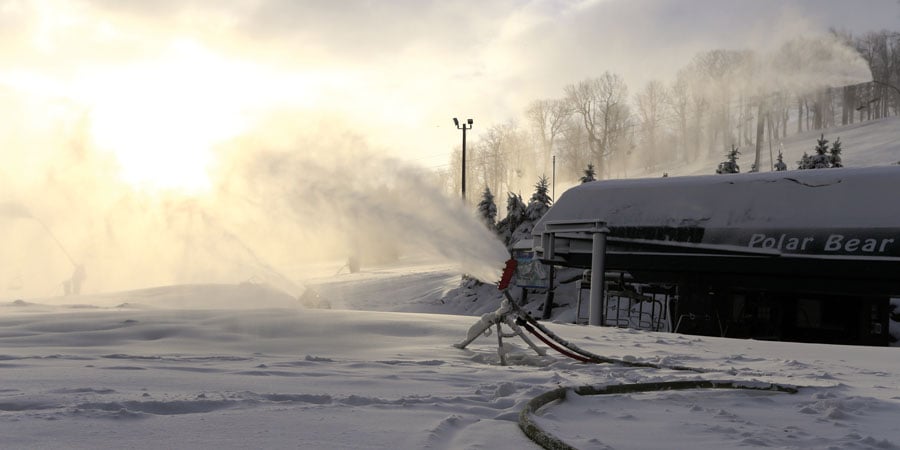
The Economics of Snow
In 2015, RRC Associates, a research firm contracted by the National Ski Areas Association, released an economic impact study on North Carolina’s ski industry. Its report found that the 2014-2015 ski season brought $197.2 million to the state, a 35.1 percent increase compared to the 2009-2010 season ($145.9 million).
The findings came as a welcome surprise. That same year, skiing nationwide was down by 5%. The Southeast ski scene, too, was down by 1.4%, but North Carolina’s was up a whopping 7.5%. There’s a two-fold answer as to why North Carolina’s skiing has seen such startling growth while other naturally snowier states are struggling. North Carolina resorts see a younger, more novice audience, largely due to the fact that the Southeast is the fastest growing region in the nation. But more importantly, North Carolina’s resorts have prioritized reinvesting profits back into the property, which means nicer facilities, better snow, and an increased likelihood that those beginner skiers will return again.
Because North Carolina does not receive as much natural snowfall as other states, resorts have been forced out of necessity to upgrade their snowmaking equipment in order to stay competitive. Cataloochee’s President Chris Bates recognized this necessary evil early on in his tenure, and in 2005, the resort automated nearly all of the snow guns on the mountain.
“When I first started here 18 years ago, our snowmaking system was probably about one-third of what it is today,” he says. “We only had two lifts at that time, where now we have three. We had about 10 trails and we ski on 18 now. We were only skiing 80 to 90 days a season, where now we’re averaging around 130 days of skiing every year.”
That total overhaul, which involved purchasing 110 snowmaking machines and replacing many of the resort’s air and water lines, wasn’t cheap. Over the course of five years, Bates estimates that Cataloochee spent about $15 million in snowmaking upgrades alone. And it doesn’t stop there. Although most tower guns could last up to 30 years with minimum maintenance required, snowmaking technology is improving at such a rapid rate that those guns become antiquated well before then. Cataloochee’s snow guns are only 13 years old, and Bates says the resort is again in the process of updating that machinery.
“In the last two years we’ve already replaced about one-third of that equipment and we’ll continue to do that because the new stuff is just a step better than what we had before,” he says. “Our investment in the equipment is 100% responsible for extending our season close to double what it was.”
The Future of Snowmaking
The equipment that Cataloochee has so wisely invested in is proof alone that the snowmaking industry is continuing to evolve in response to the pressures of climate change. While water is certainly a heavily used resource in the snowmaking process, over 80% of that water is returned to the resort’s holding ponds once it melts off of the slopes. The water is pumped, filtered, and recycled again for snowmaking use. Unlike resorts in arid, drier states out west, most Southeastern resorts can rely on rain to account for that 20% lost to evaporation.
It’s air, not water, which presents the biggest problem. Compressed air requires a lot of energy, which is why resorts are switching to automated snow guns that use substantially less compressed air than older models. Early snow guns used anywhere from 450 to 1,000cfm, where newer guns use anywhere from 20 to 140cfm. That means resorts can run more guns and make more snow with less energy.
“The guns with automation really let you get your product out there a lot quicker,” says Ober Gatlinburg’s Nighttime Snowmaking Supervisor Charlie Godwin. “You can turn on 100 guns within minutes, whereas if you have guys out there on the mountain turning [the guns] on manually, it could take them anywhere from three to five hours. Here in the South, every minute counts.”
Ober recently purchased a SnowMagic unit that can crank out 150 tons of snow in 24 hours, even when it’s 65 degrees and sunny. When I spoke to Godwin in October, he had already been running the 150-ton unit, plus three smaller 50-ton SnowMagic units that the resort is leasing, for two weeks.
It’s not the most affordable or efficient route to go: the 150-ton unit costs upwards of $400,000, compared to the average $45,000 fully automated snow gun, and covering an entire ski run in snow would require an inordinate amount of energy—that one machine uses 400 kilowatts per hour and 32 gallons of water per minute. At the very least, the combined units do allow Ober to open up its tubing park before Thanksgiving, and as Godwin says, every minute counts.
Back at Seven Springs, and in the warmth of the shop, I ask Kirk Russell what the next chapter holds for snowmaking. The industry has come a long way since the days of diesel air compressors chugging 15 gallons of fuel an hour. Still, as global warming continues to manifest itself in the form of droughts and above-average temperatures, can resorts keep up?
The best snow guns on the market already have their own weather stations, which allow snowmakers to make the most out of optimal conditions, if only for a few hours. Though Ober, Cataloochee, and Seven Springs all depend on the grid, progressive-minded resorts like Mount Abram up in Maine are increasing sustainability measures by installing solar panels in parking lots to supplement energy usage. Ski resorts everywhere are looking to diversification (most notably in the form of downhill mountain biking) to relieve pressure on the ski season to provide.
If resorts can achieve that optimum trifecta of maintaining reliable snowmaking staff, continuing to invest in energy saving equipment, and expanding off-season activities on the mountain, Russell thinks that, yes, resorts can keep up, “but it’s not going to happen overnight.”

